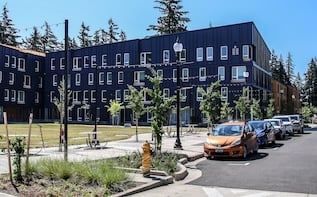- Home
- Police Department
- Police Accountability
Police Accountability
- Commit to Action
- Body-Worn Cameras
- Bias-Free Policing and Hiring
- Training and Wellness
The Gresham Police Department is listening to our residents and acting on suggestions on how to keep our community safe.
In response to community calls for reform, we've signed the national Commit to Action pledge.
The City will:
- Review our police use of force policies. We are in this stage.
- Engage the community in our review. We are planning for this.
- Report our findings to the community.
- Reform our community’s police use of force policies, as appropriate.
One step we are taking is sharing our practices and policies with you around using force.
Police use of force policies
As a start, we provide a summary here of some key components of our use of force policy, and the full policy manual.
Out of 74,000 calls for service each year, Gresham Police employs force in less than 0.2%.
- Chokeholds and strangleholds: Chokeholds and strangleholds are not allowed, trained or words we use. Carotid restraint is not allowed unless deadly force is authorized. An officer may use deadly physical force to protect himself or others from what he reasonably believes is an imminent threat of death or serious physical injury.
- De-escalation is required: Officers must de-escalate situations where possible. Our scenario-based training gives officers the opportunity to use de-escalation techniques such as talking to calm a situation. These scenarios also help our officers learn when de-escalation is not appropriate, such as in active and unfolding incidents with increased risk to the public, subject and officers.
- Warning before shooting is required: Gresham Police trains its officers to identify themselves and give warnings if possible. However, in some situations, there is not time to give warnings.
- Exhaust alternatives before shooting: Gresham police officers are trained and expected to value human life. Officers use deadly force when there are no alternatives. In the last 21 years, Gresham police officers were involved in five officer involved shootings resulting in the death of the suspect. There are thousands of incidents each year where officers are legally justified to use deadly force, but officers choose to use an appropriate and lawful alternative.
- Duty to intervene: Officers must intervene and stop excessive force then report these incidents at once to a supervisor. Officers are also trained to recognize these circumstances and intervene before excessive force is used.
- Shooting at moving vehicles: Officers may only discharge a firearm at a moving vehicle or its occupants when the officer reasonably believes there are no other reasonable means available to prevent the threat of the vehicle, or if deadly force other than the vehicle is directed at the officer or others.
- Evaluating when to use force: Officers must know whether their actions follow state and federal laws. Our police department has set up more restrictions on use of force beyond federal law, including restrictions on vehicle pursuits, handcuffing, Tasers and more. Learn more on our Police Department Policies page.
- Comprehensive reporting required: Officers must complete a report each time they use force, which is independently reviewed by an officer’s immediate supervisor, their Watch Commander, their supervising captain, the Chief of Police, and survival skills trainer officers.
More questions?
Submit your comments or questions here:
Gresham Police began fully using body-worn cameras in January and was the first jurisdiction in Multnomah County to make use of this law enforcement tool.
Body-worn cameras provide more documentation of police-public encounters and can be a tool for collecting evidence and keeping public trust.
- When is the camera turned on? Oregon law states officers must activate a camera whenever they have reasonable suspicion while in the field. But Gresham Police are going one step further. Any time an officer has an interaction with a member of the community, they will turn on the camera and keep it on until the end of that contact. Once an officer taps the button, the camera will record the 30-second interval preceding its activation. There are exceptions for sensitive instances like delivering death notifications, interactions in courtrooms and undercover situations.
- Notice required: Gresham officers will announce when they begin recording, unless doing so would jeopardize their safety or harm an investigation.
- How will footage be used? Footage can be used to supplement officer reports, training, and for professional standards review and investigation in resolving resident complaints.
- How are the videos stored? Videos are uploaded to a secure centralized system. Each recording stays in the system for at least 180 days. Then any non-priority recording – like a routine traffic stop – is removed. Individual officers are not allowed to edit or delete footage.
Request body-worn camera video.
Read the complete body-worn camera policy on the Police Policies page.
An Oregon Criminal Justice Commission report found in 2019 that Gresham Police did not overly cite, search or arrest Black or Hispanic residents, based on data from officer-initiated traffic and pedestrian stops.
The Police department prioritizes implicit bias training for its officers. Gresham Police responds to an average 74,000 calls for service in a year. In the past two years, there have been only four bias-based complaints.
We welcome all qualified job applicants and strive to employ officers who reflect the demographics of our community. The percentage of officers who are Black, Native American, Pacific Islander and Asian reflect Gresham’s demographics.
While there has been an increase in recent years of Hispanic and women officers, the department is working on improving these percentages because they do not mirror the demographics of our city.
Gresham Police officers must complete yearly training including mental health, diversity and profiling, equity and inclusion, and implicit bias.
Diversity and profiling training
- Cultural and identity groups awareness, knowledge and communication.
- Promoting teamwork without using race or physical characteristics to influence or guide decision making.
Equity and inclusion training
- Teaches officers to treat all people fairly and justly.
- Empowers officers to be part of the solution process regardless of their race, orientation, background, economic standing, physical characteristics or beliefs.
Implicit bias training
- Educates officers on recognizing their own unconscious bias.
- Trains officers to meet the unique needs and characteristics of minority communities, whether they are victims or witnesses of crimes, subjects of stops, or criminal suspects.
Mental health training
- Trains officers to recognize symptoms of a mental health crisis, enhances their confidence in addressing such an emergency, and reduces inaccurate beliefs about mental illness.
- After completing Crisis Intervention Training (CIT) orientation, officers felt encouraged to interact with people suffering a mental health crisis and to delay a “rush to resolution.”
The department places a priority on officer wellness and mental health. Officers can consult with a police psychologist, access a Peer Support program and Police Chaplains, and can take part in a wellness program that includes physical, emotional, and mental health resources.





